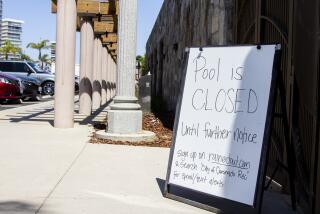Time to Ready Pool, Hot Tub for Summer
The warm summer months are closing in, so it may be time to think about getting the pool, spa or hot tub ready. Otherwise, it might be difficult to enjoy any of them if you are constantly fretting about maintenance.
But it doesn’t take much time or effort to get any of them in shape for the season, says Kirk Mitchell, chief chemist for Hydrotech Chemical Corp., a supplier of pool products.
Mitchell offered the following steps for preparing and maintaining pools, spas and hot tubs:
Pools: “First and foremost, arm yourself with a test kit that has fresh reagents, or your readings could prove misleading,” Mitchell said.
At the minimum, the kit should enable you to check the bromine or chlorine sanitizer, the pH and total alkalinity. It’s also a good idea to equip your test kit to measure calcium hardness and acid and base demand, he said.
“Especially at pool opening time, you should double-check your own findings by scooping up a 1-quart sample of water into a clean plastic container and taking it to your professional pool dealer for analysis,” Mitchell said.
If the dealer’s findings match yours, you’re OK; if not, find out why the test results don’t agree and make the necessary adjustments.
If you aren’t happy with your present sanitizing system because of an unpleasant odor or skin irritation, Mitchell suggested using brominated sanitizers that contain Chlorfree.
“You’re less likely to get either the smell or itching that sometimes results when chlorine combines with waste products to form contaminants known as chloramines,” he said.
It’s also a good idea to “shock” the pool to make sure all organic wastes have been treated, Mitchell said. Traditionally, pool contaminants such as chloramines are treated by adding more chlorine, a process known as super-chlorination or break-point chlorination.
In order to prevent algae growth, he recommended adding an algaecide. Since you must first injure algae or slime growth before you can kill it, Mitchell suggested that before applying any chemicals, you give the walls of the pool a good scrubbing with a strong brush.
Hot tubs and spas: The first step involves determining the hot tub or spa’s exact capacity so the right amount of chemicals are used, and getting a water test kit that measures bromine and pH level as well as for total alkalinity.
Next comes the task of balancing five factors: the water’s pH, total alkalinity, calcium hardness, temperature and total dissolved solids. The pH or acid-base balance should range from 7.4 to 8.0
“Never should the pH go below 7.0 or above 8.4,” said Mitchell.
Should calcium hardness or total alkalinity get too high, he said, “Just drain part of the water and refill with fresh tap water, until tests show you’ve reached the manufacturer’s recommended levels.”
For sanitizing, Mitchell believes bromine rather than chlorine-based products should be used because bromine works without imparting either the smell or skin and eye irritations commonly associated with chlorine.
The actual dosage of bromine will vary depending on the size of the tub, but a general rule is to maintain a bromine residual of 2 to 4 parts per million.
One exception to that rule is with new hot tubs, Mitchell said.
“A new hot tub will leach tannic acid and a natural wood component called lignin into the water, giving it a brown, murky look,” he said. “This is expected, and should stop within six to eight weeks.
“In the meantime, the bromine residual should be kept somewhat higher, at 3 to 5 parts per million, and the water drained and refilled at least once a week until the leaching stops.”

